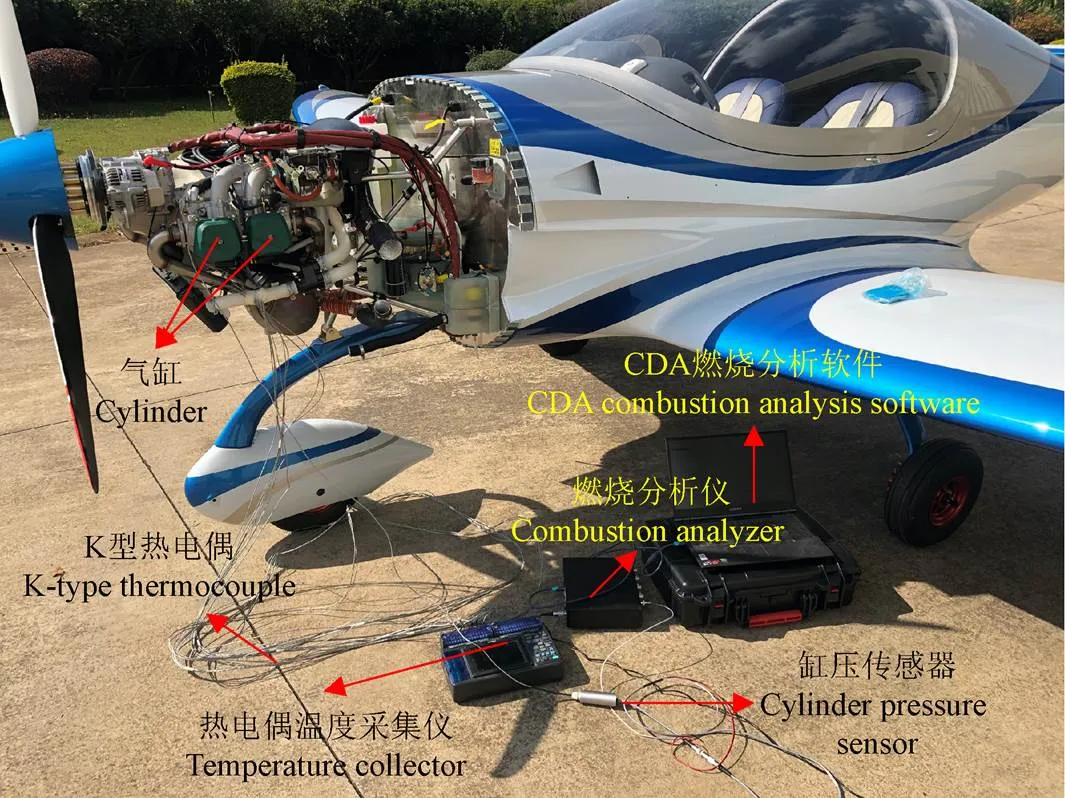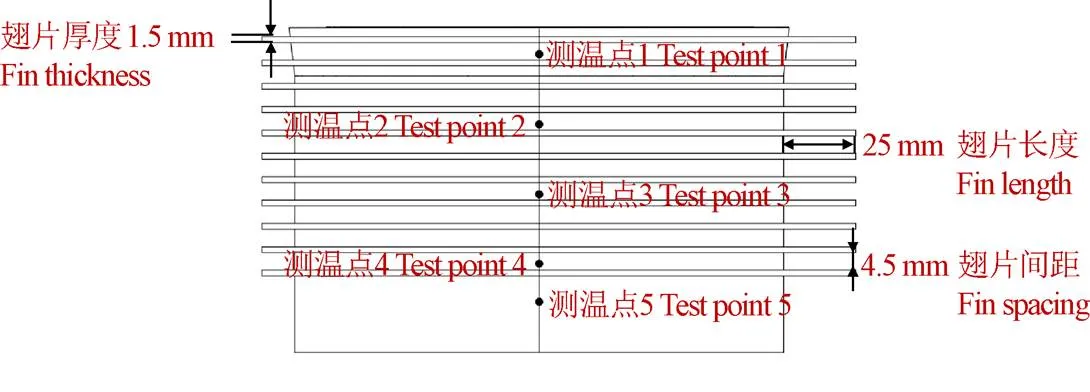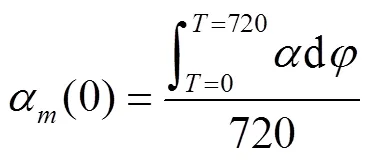翅片结构对航空活塞式风冷发动机缸体强度与传热性能的影响
雷基林,肖顺文,邓 伟,邓晰文,田 鏖,董 林
翅片结构对航空活塞式风冷发动机缸体强度与传热性能的影响
雷基林1,肖顺文1,邓 伟1※,邓晰文1,田 鏖2,董 林2
(1. 昆明理工大学,云南省内燃机重点实验室,昆明 650500;2. 弥勒浩翔科技有限公司,弥勒 652300)
航空活塞式风冷发动机由于结构紧凑、体积小、质量轻等优势,在通用航空、农业等领域得到广泛运用。针对航空活塞式风冷发动机热负荷问题,该研究以某水平对置四缸四冲程航空活塞风冷汽油机为研究对象,试验测试了标定功率工况下发动机缸内压力,结合缸压试验数据与风冷发动机缸体的结构与传热特性,搭建一维仿真模型,计算获得了缸内燃气侧边界条件。采用热电偶法测试了标定功率工况下缸体关键区域的工作温度,结合缸体温度测试数据与缸内各位置的温度和传热系数,建立流固耦合仿真模型。选择翅片厚度、翅片间距、翅片长度3个主要结构参数分析其对缸体结构强度及传热性能的影响。结果表明,翅片结构对缸体的强度及传热性能影响较大,翅片厚度增大使得温度最大下降19.8 ℃、应力最大下降33.0 MPa。以翅片厚度、翅片间距、翅片长度3个翅片主要结构参数为因素设计正交试验,计算结果表明,翅片长度变化对缸体温度影响最大;选取最优值优化后与原机相比温度最大下降18.2 ℃。翅片厚度对翅片强度影响最大,选取最优值优化后与原机相比热应力最大下降50.1 MPa。研究结果可为航空活塞风冷发动机散热翅片的设计与优化提供参考依据。
流固耦合;传热;风冷发动机;缸体;强度;散热翅片
0 引 言
航空活塞式风冷发动机因其结构简单紧凑、重量轻、制造成本低、设计开发周期短等显著优势,近年来在通用航空、民用、农业、国防军事等领域发展迅速。在现代农业中,航空活塞式风冷发动机在施肥、播种、航测、植保、灾害防治等方面作用巨大,且效率高、优越性明显,同时航空活塞式风冷发动机的作业不受地理因素制约,无论是地面机械难以进入的山区、滩涂等地,或是害虫滋生的区域,都可精准高效的完成作业任务[1-4]。随着运用范围的逐渐扩大,对飞机有着飞得更高、续航更长、可靠性更好的要求[2]。航空活塞式发动机因其轻量化需求,同时由于发动机在高空低温环境下工作冷却水容易结冰,缸体大多采用铝合金材料,发动机冷却方式以风冷为主。风冷散热能力相对水冷较弱,易造成部分温度较高。铝合金材料在高温下强度迅速下降,影响缸体结构强度和可靠性,从而影响飞行的安全性能。因此,缸体热负荷与强度的优化设计是先进的航空活塞式风冷发动机自主研发重点解决的问题之一[5-8]。
翅片结构对航空活塞式风冷发动机传热有重要的影响[9-11]。2017年蔡惠坤等[12]对不同的翅片结构进行了变海拔工况下的性能分析,将海拔当作变因素,研究了百叶窗型翅片、平直型翅片、波纹型翅片、锯齿型翅片四种常用的翅片散热器型式的散热性能,得出在海拔5 000 m以下的飞行高度内,波纹型翅片受海拔的影响最小,同时波纹型翅片的散热性能较差;锯齿形翅片受海拔的影响最大,但是锯齿形翅片的散热能力在2 000 m海拔以上时小于百叶窗型的翅片。Elsayed等[13]以平板型翅片作为研究对象,以翅片的厚度、间距、数量作为研究对象,得到不同海拔高度下各结构参数对翅片热阻影响的变化规律。结果显示,不同的海拔高度都有与之对应的最优结构参数。
为探究不同翅片结构对缸体强度与传热性能的影响,以某企业开发的水平对置四缸四冲程航空活塞式风冷汽油机缸体为研究对象,建立发动机GT-Power一维仿真模型,得到缸内热边界条件;采用热电偶测温法测试分析标定功率工况下缸体温度分布,并结合试验值建立包括缸盖、缸体、曲轴箱、轴瓦、曲轴、外冷却流场在内的流固耦合传热仿真模型[14-17],仿真分析翅片厚度、翅片间距、翅片长度3个翅片结构参数对缸体强度与传热性能的影响。
1 缸内压力与缸体温度试验测试
为探究散热翅片结构对航空活塞式风冷发动机强度与传热性能的影响,基于一台水平对置四缸四冲程风冷汽油机进行试验,试验机型基本参数如表1所示,试验测试图如图1所示。

表1 发动机主要参数

图1 气缸温度和压力测试
1.1 缸内压力测试
缸压测试系统主要由压电式缸压传感器、燃烧分析仪、计算机等设备组成。如图1所示,缸压传感器安装于发动机火花塞侧,实时测量在额定转速3 000 r/min时的缸内压力,并传递给燃烧分析仪,再通过计算机上的燃烧分析软件实时监测并记录试验数据。
1.2 缸体温度测试
缸体温度测试系统主要由K型热电偶、温度采集仪等设备组成(图1)。热点偶一端通过高温无机胶粘附于缸体背风面位置,测温点分布见图2,并对多余胶水进行清理,以尽量避免对流场产生的影响;另一端连接到温度采集仪,测试在转速3 000 r/min时的缸体温度数据,通过温度采集仪实时监测与记录。

图2 缸体测温点及翅片结构参数示意图
2 一维仿真模型与试验验证
2.1 一维仿真模型
运用GT-Power软件对发动机工作过程进行建模,模型设定零部件结构参数、点火顺序、气门升程曲线、进排气道壁面温度等,转速为3 000 r/min,环境温度为300 K,压力边界为当地大气压,燃烧模型为韦伯模型。一维模型见图3。

图3 GT-Power一维仿真模型
2.2 模型验证
采用压电式缸压传感器对发动机进行缸压测试,。对比试验与仿真的缸压曲线,发现其吻合度较高,平均误差为4.8%,满足计算需要[18]。试验与仿真的缸压曲线如图4所示。

图4 缸内压力仿真值与试验值对比
3 流固耦合模型与试验验证
3.1 缸内燃气侧与冷却空气侧换热边界条件
3.1.1 燃气侧换热边界条件
发动机在额定工况下运行时,缸内燃气瞬时温度高达2 000 K,而缸体外部冷却空气温度则在零度上下几十度范围内[19]。所以确定缸体壁面内外侧热边界条件是探究缸体热负荷的关键[20-22]。
缸体壁面内外侧的传热均以对流换热为主要换热方式,在加载时选取第三类边界条件。一维仿真得出的燃气瞬时温度、压力、换热系数随曲轴转角的变化关系如图5所示。

图5 瞬时温度、压力、换热系数的变化曲线
目前耦合对流换热与辐射换热来研究缸内传热的过程实现起来有一定难度,且没有具体稳定可行的方法,而从前人所发表的众多缸内耦合传热方面的文献资料来看,单独只考虑对流换热而不考虑其他换热方式的仿真计算,已经足够指导设计研究工作[23-26]。所以对于缸内边界条件的计算仅需考虑对流换热。仿真分析计算,需选择经验公式计算缸内燃气在一个循环内的平均温度和平均换热系数,相应的计算公式[27]如下:


式中α(0)为活塞上止点处的燃气平均传热系数;T(0)为活塞上止点处的燃气平均温度,℃;代表图3中的瞬时换热系数;代表瞬时温度,℃。
由于活塞在缸内进行往复式运动做功,使得燃气与缸体内壁各位置所接触的时间均不同,以致在气缸轴向上的换热系数和温度分布呈一定的规律;根据文献[27]中缸内稳态传热边界条件研究得知计算距离活塞上止点处位置的燃气平均温度T()和平均换热系数α()的经验公式为


其中1=0.573(/)0.24,2=1.451,为气缸直径,mm;为活塞行程,mm;=/(0≤≤),为距离活塞上止点处的距离,mm。
根据文献[18]分区施加边界条件内容得知,将缸体内壁轴线分成5个区域以内时,各区域换热系数数值差异过大,分成7个区域及以上时,远离上止点区域换热系数数值基本相同,本文将缸体内表面分成6个区域。由式 (1)和式(2)结合温度瞬时变化曲线、换热系数瞬时变化曲线计算得到α(0)=347.7 W/(m2·℃),T(0)= 1 332.65 ℃。联立式(1)~(4),计算得出不同区域下的燃气平均温度和平均换热系数,并与每个区域底边距离上止点的距离一起列于表2中,缸内区域划分示意图见图6。

表2 缸内部分位置热边界条件

图6 缸内区域划分
3.1.2 冷却空气侧换热边界条件
采用Fluent计算流体侧边界条件,由于流场较为复杂,所以选择适用范围更广、更适合模拟复杂几何的外部流动的K-epsilon湍流模型。冷却空气温度设定为300 K;冷风入口采用速度入口,风速与螺旋桨转速有关,在3 000 r/min时测试风速为26 m/s;出口设定为压力出口,压力为当地大气压;通过施加以上边界条件,fluent计算得出流固交界面换热系数与温度,并输出至缸体外表面作为缸体热分析的边界条件。

式中ε为温度修正系数,ε=(T/T)0.3。ε为弯管修正系数,ε=1+1.77d/。为流道长度,m。为流道曲率半径,m。ε为流道长度修正系数,ε=1.13。P为普朗特数。λ为空气导热系数,W/(m·K)。d为散热片槽当量直径,d=4/,mm,其中和分别为翅片面积和周长。R为雷诺数,R=υd/υ,其中为冷风流速,m/s,υ为空气运动黏度;R<2 200为层流流动,2 200≤R≤10 000为过渡流流动,R>10 000为湍流流动。
3.2 流固耦合仿真模型
建立模型时假设来流只受缸盖、缸体的影响,且流场足够大,以确保流场外边界的绝热条件,实体模型见图7a。采用四面体网格进行划分,对流固接触面、关键区域进行网格加密处理,最终划分流场网格352万,网格纵横比为23.96,多部件在内的固场网格230万,网格纵横比为15.54,网格模型图见图7b,根据前文所得的热边界条件,利用Workbench软件对模型进行弱流固耦合传热分析。

图7 流固耦合模型
冷风的截面流线图见图8a。缸体接受缸内高温燃气传来的大量的热,通过翅片与冷风进行对流换热;从图 8a可以看到,在缸体背风面,冷风流速缓慢,致使换热系数较低,散热效果较差。缸体的背风面温度场云图见图 8b,由图8b可以看出,缸体在轴向上温度分布差异较大,最高温度为233.9 ℃,位于缸体顶部靠近排气道位置;最低温度位于最下层翅片末端。由于背风面散热效果较差,且缸体背风面左右两侧的流速较快、散热效果好,同时远离上止点的位置缸体内部燃气温度下降,在图8b中显示的背风面温度云图呈现由上至下温度下降、从中间到两边逐步降低的趋势。
缸体的热应力云图见图8c,最大应力为106.57MPa,出现在排气侧第一层翅片末端,且燃烧室附近的翅片应力均较高。

图8 原机缸体仿真云图
综上所述,散热翅片散热的方式是航空活塞风冷发动机散热的主要方式,由于背风面流速较低换热效果差,高温位置出现在背风面上端,缸体的热应力集中位置出现在排气侧顶部翅片末端。
3.3 温度场试验测试与验证
热电偶测温法具有线性度好、灵敏度高、稳定性好等优点。本文采用热电偶测温法测量缸体在额定转速3 000 r/min时的温度。测试结果见表3。
结合温度仿真结果与温度试验值对比,相对误差均没有超过5%,根据一般工程需要[26-27],仿真结果较为准确,可以满足后续分析要求。

表3 温度测试值与仿真值对比
4 翅片结构对缸体强度和传热性能的影响
为研究缸体散热翅片主要结构参数对缸体传热和强度的影响,根据上述温度和应力仿真分析结果,选择散热翅片厚度、翅片长度、翅片间距3个主要结构参数(图 2),分别研究各参数对缸体强度及传热性能的影响程度。
如图9a所示,选取缸体内壁迎风面、背风面、进气侧、排气侧4个位置,每个位置选取轴向上的5个点,共20个点评定缸体的整体温度场。如图9b所示,选取第一二层翅片的迎风面、背风面、进气侧、排气侧末端位置共8个点来评定缸体的热应力。

图9 缸体温度及热应力测点
在改变翅片某一结构参数且保持其余参数不变的情况下,采用原缸体仿真计算的边界条件,分析缸体的温度与应力变化,绘制成柱状图。
4.1 翅片厚度对缸体强度和传热性能的影响
为探究翅片厚度对缸体强度与传热性能的影响,保持翅片长度为25 mm、翅片间距为4.5 mm不变,为翅片厚度(初始值为1.5 mm)选择1、2、2.5和3 mm进行分析研究。缸体测点的温度场结果如图10a所示,热应力结果如图10b所示。
由图10a可以看出,改变翅片厚度对缸体的温度场分布影响很大,最大下降19.8 ℃,出现在点5位置,最大上升13.8 ℃,出现在点9位置。增加翅片厚度后,背风面点6、7、8和两侧点11、12、16、17出现温度先下降后上升的趋势其余各点均出现明显的下降趋势。减小翅片厚度各点温度均出现不同程度的下降。
如图10b所示,改变翅片厚度使得部分点热应力变化明显。减小翅片厚度使得排气侧测点热应力最大上升34.9 MPa;增大翅片厚度使得排气侧测点热应力最大下降33.0 MPa。
综上可知,改变翅片厚度对缸体温度与热应力均有显著的影响;翅片厚度减薄使得整体温度上升;翅片厚度增厚使得整体温度场下降,部分点呈现先降后升趋势。翅片厚度对热应力影响较大,适当增加翅片厚度会减小热应力。当选择翅片厚度为2 mm时,各点温度与热应力均出现一定程度的下降。

图10 翅片厚度对测点温度与热应力的影响
4.2 翅片长度对缸体强度和传热性能的影响
为研究翅片长度对缸体强度与传热性能的影响,保持翅片厚度1.5 mm、翅片间距4.5 mm不变,为翅片长度(初始值为25 mm)选取19、22、28和31 mm进行分析,缸体测点温度分布如图11a所示,热应力结果见图11b。
由图11a可以看出,改变翅片长度对温度场影响较大。减小翅片长度使得点13温度最大上升24.8 ℃。增大翅片长度使得点11温度最大下降14.5 ℃。减小翅片长度使得各点温度都呈上升趋势;增大翅片长度使得温度呈下降趋势,而增大翅片长度使得背风面各点温度下降缓慢。
由图11b可见,各点变化趋势总体相同。减小翅片长度使得热应力下降,排气侧测点下降最为明显,最大下降28.2 MPa。增大翅片长度使得应力均有所上升,点2、3、4、8变化较为显著,最大上升达到23.9 MPa。

图11 翅片长度对测点温度与热应力的影响
综上所述,改变翅片长度对缸体温度与热应力影响较大。增长翅片长度,相当于大幅增加翅片的绝对面积,从而增强换热效果,引起温度明显下降,但是应力会明显上升;减短翅片长度,相当于减少翅片面积,削弱换热效果,致使温度明显上升,而应力显著下降。
4.3 翅片间距对缸体强度和传热性能影响
为研究翅片间距对缸体强度与传热性能的影响,保持翅片长度25 mm、翅片厚度1.5 mm不变,为翅片间距(初始值为4.5 mm)选择2.5、3.5、5.5和6.5 mm进行分析。缸体温度分布见图12a所示,热应力变化见图 12b。
由图12a可以看出,翅片间距变化使得温度变化明显。当翅片间距变小时,点1、2、11、16、17温度均呈下降趋势,而其余各点均出现不同程度上的上升。当翅片间距变大时,点4、5、9、10、14、15、19、20均有不同程度的下降,最大下降13.5 ℃,而其余各点呈不同程度的上升;此为翅片下移为下端各点带来的换热效果的提升。
由图12b所见,改变翅片间距,对缸体热应力变化有一定的影响。减小翅片间距对点8位置热应力影响稍大,呈先降后升趋势,最大下降24.1 MPa。增大翅片间距使得热应力变化稍小,最大上升6.9 MPa,其余位置变化均较小。
综上所述,改变翅片间距对温度与热应力均有一定程度的影响。当减小翅片间距时,将引起迎风面、背风面、进气侧、排气侧各面高温度点(点1、2、6、11、16、17)温度下降而其他点上升;点8位置热应力变化明显而整体热应力变化不大。当增大翅片间距时,将引起迎风面、背风面、进气侧、排气侧各面由上至下前2点的温度升高,其他点的温度降低;整体热应力变化较小。

4.4 翅片结构对缸体强度与传热性能的正交分析
正交试验设计基于“均衡分散、整齐可比”的思想,在满足工程设计的情况下选取翅片厚度、翅片长度、翅片间距作为正交试验因素。以缸体内壁背风面点6的温度值与第一层翅片末端的应力值为优化目标,结合上述仿真结果,设置3因素5水平正交试验,因素水平表见表4,极差分析结果如表5。

表4 正交试验因素水平表

表5 温度与热应力的极差分析
根据表5极差分析可知,各因素对缸体温度的影响程度从大到小分别为翅片长度、翅片厚度、翅片间距。各因素对翅片应力的影响程度由大到小分别为翅片厚度、翅片长度、翅片间距。图13、图14展示了各因素值对缸体温度与热应力的影响趋势。选取对影响温度的最优组合翅片厚度2 mm、翅片长度31 mm、翅片间距4.5 mm及对影响热应力的最优组合翅片厚度3 mm、翅片长度19 mm、翅片间距2.5 mm分别做仿真分析,发现各测点温度与热应力均有下降,温度最大下降18.2 ℃,热应力最大下降50.1 MPa,具体见图15。

图13 各因素对缸体温度的影响趋势

图14 各因素对缸体热应力的影响趋势

图15 优化前后测点温度与热应力的对比
5 结 论
1)通过试验与仿真结合的方法,利用相应的经验公式获取了航空活塞风冷发动机运行时缸内与缸外的热边界条件,采用流固耦合的方法计算缸体在稳态下的温度场分布,得出测点的温度与应力。将温度、缸压仿真值与试验结果比对,相对误差均在5%以内,仿真结果可靠。
2)分析缸体翅片结构参数对缸体传热及强度的影响,得出翅片长度的变化对缸体温度场影响较大,温度最大下降19.8 ℃,最大上升24.8 ℃;翅片厚度变化对缸体温度场有一定程度的影响。翅片厚度的变化对热应力的影响较大,翅片长度对热应力的影响稍大,翅片间距的变化对热应力的影响稍小,应力最大上升34.9 MPa,最大下降33.0 MPa。
3)通过试验设计分析,翅片长度对温度的影响程度最大,其次为翅片厚度;最优组合为翅片厚度2 mm,翅片长度31 mm,翅片间距4.5 mm;优化后温度最大下降18.2 ℃。翅片厚度对热应力影响程度最大,其次为翅片长度;最优组合为翅片厚度3 mm,翅片长度19 mm,翅片间距2.5 mm;优化后热应力最大下降50.1 MPa。
[1] 李杰. 活塞式无人机发动机直喷航空煤油喷雾及燃烧特性的试验研究[D]. 天津:天津大学,2019.
Li Jie. Experimental Study on Spray and Combustion Characteristics of Direct Injection Aviation Kerosene in a Piston UVA Engine[D]. Tianjin: Tianjin University, 2019. (in Chinese with English abstract)
[2] 陈刘忠. 无人机综合热管理系统建模与仿真[D]. 南京:南京航空航天大学,2016.
Chen Liuzhong. The Modeling and Simulation of UAV Integrated Thermal Management System[D]. Nanjing: Nanjing University of Aeronautics and Astronautics, 2016. (in Chinese with English abstract)
[3] 董彦非,黄明,李瑞琦. 通用航空发动机发展综述[J]. 西安航空学院学报,2017,35(5):8-13.
Dong Yanfei, Huang Ming, Li Ruiqi. Overview of the development of general aviation engines[J]. Journal of Xi'an Aeronautical University, 2017, 35(5): 8-13. (in Chinese with English abstract)
[4] 王山. 航空活塞直喷汽油机缸内工作过程特性研究[D]. 北京:北京理工大学,2016.
Wang Shan. The Research on Operation Characteristic of Piston Aero-Gasoline Engine[D]. Beijing: Beijing Institute of Technology, 2016. (in Chinese with English abstract)
[5] 沈颖刚,聂珂,徐劲松,等. 不同海拔下压燃式航空活塞发动机的燃烧与排放特性[J]. 推进技术,2022,43(4):248-256.
Shen Yingang, Nie Ke, Xu Jingsong, et al. Combustion and emission characteristics of compression-ignition aero piston engine at different altitudes[J]. Propulsion Technology, 2022, 43(4): 248-256. (in Chinese with English abstract)
[6] 唐梓杰,丁水汀,杜发荣. 小型航空二冲程风冷发动机缸体流固耦合传热的仿真[J]. 航空动力学报,2011,26(1):42-47.
Tang Zijie, Ding Shuiting, Du Farong. Simulation of fluid-solid coupled heat transfer of cylinder a small two-stroke air-cooled aero-engine[J]. Journal of Aerospace Power, 2011, 26(1): 42-47. (in Chinese with English abstract)
[7] 周龙保. 内燃机学(第二版)[M]. 北京:机械工业出版社,2005:228-260.
[8] 李卫东,赵廷渝. 航空活塞动力装置[M]. 成都:西南交通大学出版社,2004.
[9] Zheng X, Luo X, Luo J, et al. Experimental investigation of operation behavior of plate heat exchangers and their influences on organic Rankine cycle performance[J]. Energy Conversion and Management, 2020, 207(3): 112528.
[10] 董军启,陈江平,袁庆丰,等. 板翅换热器平直翅片的传热与阻力性能试验[J]. 农业机械学报,2007,38(8):53-56.
Dong Junqi, Chen Jiangping, Yuan Qingfeng, et al. Flow and heat transfer on compact smooth fin surfaces[J]. Transactions of the Chinese Society for Agricultural Machinery, 2007, 38(8): 53-56. (in Chinese with English abstract)
[11] 杨艳霞,马晴婵,左玉清. 人字形板式换热器流道传热特性及参数优化[J]. 农业工程学报,2019,35(21):210-215.
Yang Yanxia, Ma Qingchan, Zuo Yuqing. Heat transfer characteristics and parameter optimization of flow passage of herringbone heat transfer[J]. Transactions of the Chinese Society of Agricultural Engineering (Transactions of the CSAE), 2019, 35(21): 210-215. (in Chinese with English abstract)
[12] 蔡惠坤,张银亮,廖亦戴,等. 多海拔下不同散热器翅片的性能分析[J]. 华南理工大学学报(自然科学版),2017,45(2):91-98.
Cai Huikun, Zhang Yinliang, Liao Yidai, et al. Performance Analysis of different radiator fins at various altitudes[J]. Journal of South China University of Technology (Natural Science Edition), 2017, 45(2): 91-98. (in Chinese with English abstract)
[13] Elsayed M L, Mesalhy O, Kizito J P, et al. Performance of a guided plate heat sink at high altitude[J]. International Journal of Heat and Mass Transfer, 2020, 147: 118926- 118941.
[14] Bajargaan R, Patel A. Self similar flow behind an exponential shock wave in a self-gravitating, rotating, axisymmetric dusty gas with heat conduction and radiation heat flux[J]. Indian Journal of Physics, 2018, 92(9): 1119-1135.
[15] Liu Y C, Sangeorzan B, Alkidas A. Experimental investigations into free-circular upward-impinging oil-jet heat transfer of automotive pistons[J]. SAE International Journal of Engines, 2017, 10(3): 790-801.
[16] 邓晰文,雷基林,文均,等. 活塞结构参数对柴油机活塞传热与温度场的影响分析[J]. 农业工程学报,2017,33(10):102-108.
Deng Xiwen, Lei Jilin, Wen Jun, et al. Influences of piston structural parameters on heat transfer and temperature field of diesel engine piston[J]. Transactions of the Chinese Society of Agricultural Engineering (Transactions of the CSAE), 2017, 33(10): 102-108. (in Chinese with English abstract)
[17] 童宝宏,张强. 不同工况下柴油机活塞变形的三维有限元分析[J]. 农业工程学报,2010,26(9):159-163.
Tong Baohong, Zhang Qiang. 3-D finite element analysis of piston deformation under different operating conditions of diesel engine[J]. Transactions of the Chinese Society of Agricultural Engineering (Transactions of the CSAE), 2010, 26(9): 159-163. (in Chinese with English abstract)
[18] 邓晰文,林贤衍,贾德文,等. 柴油转子发动机的全可变配气系统优化[J]. 农业工程学报,2021,37(4):114-121.
Deng Xiwen, Lin Xianyan, Jia Dewen, et al. Optimization of fully variable valve system in a diesel rotary engine[J]. Transactions of the Chinese Society of Agricultural Engineering (Transactions of the CSAE), 2021, 37(4): 114-121. (in Chinese with English abstract)
[19] 姬芬竹,杜发荣,徐斌,等. 航空用风冷活塞式发动机热状态研究[J]. 内燃机工程,2014,35(1):35-40.
Ji Fenzhu, Du Farong, Xu Bin, et al. Research on Thermal state of air-cooled piston engine for aviation[J]. Chinese Internal Combustion Engine Engineering, 2014, 35(1): 35-40. (in Chinese with English abstract)
[20] 陈红岩,李婷. 柴油机活塞-缸套-冷却水系统固流耦合传热研究[J]. 农业机械学报,2006,37(5):37-40.
Chen Hongyan, Li Ting. Diesel engine piston-liner coolant system fluid-solid coupling heat transfer[J]. Transactions of the Chinese Society for Agricultural Machinery, 2006, 37(5): 37-40. (in Chinese with English abstract)
[21] 辛喆,张克鹏,谢斌,等. 耦合法用于柴油机冷却系统传热的研究[J]. 农业工程学报,2010,26(1):177-181.
Xin Zhe, Zhang Kepeng, Xie Bin, et al. Heat transfer in diesel engine cooling system using coupled method[J]. Transactions of the Chinese Society of Agricultural Engineering (Transactions of the CSAE), 2010, 26(1): 177-181. (in Chinese with English abstract)
[22] 俞小莉,郑飞,严兆大. 内燃机气缸体内表面稳态传热边界条件的研究[J]. 内燃机学报,1987,5(4):42-50.
Yu Xiaoli, Zheng Fei, Yan Zhaoda. The research of the boundary conditions of steady thermal conduction on the inner surface of cylinder in internal combustion engines[J]. Transactions of CSICE, 1987,5(4): 42-50. (in Chinese with English abstract)
[23] 陈红岩,李迎,李孝禄. 柴油机流固耦合传热仿真研究[J]. 中国计量学院学报,2007,17(4):284-288.
Chen Hongyan, Li Ying, Li Xiaolu. Simulation study on the fluid-solid coupled heat transfer of diesel engines[J]. Journal of China Jiliang University, 2007, 17(4): 284-288. (in Chinese with English abstract)
[24] 李迎,俞小莉,陈红岩,等. 发动机冷却系统流固耦合稳态传热三维数值仿真[J]. 内燃机学报,2007,25(3):252-257.
Li Ying, Yu Xiaoli, Chen Hongyan, et al. 3-D simulation of steady heat-transfer of fluid-solid coupled system in engine coolant system[J]. Transactions of CSICE, 2007, 25(3): 252-257. (in Chinese with English abstract)
[25] 赵立峰,李云清,王海鹰,等. 风冷航空发动机的活塞形状恢复研究[J]. 航空动力学报,2009,24(10):2255-2259.
Zhao Lifeng, Li Yunqing, Wang Haiying, et al. Piston reshapes study forthe air-cooled engine of aerial vehicle[J]. Journal of Aerospace Power, 2009, 24(10): 2255-2259. (in Chinese with English abstract)
[26] 黄润伍,黄荣华,代辉,等. 海拔高度对柴油机活塞温度及热负荷的影响[J]. 内燃机学报,2019,37(3):280-287.
Huang Runwu, Huang Ronghua, Dai Hui, et al. Influences of altitude on piston temperature and thermal load of a diesel engine[J]. Transactions of CSICE, 2019, 37(3): 280-287. (in Chinese with English abstract)
[27] 王俊, 申立中, 杨永忠, 等. 基于响应曲面法的非道路用高压共轨柴油机设计点优化标定[J]. 农业工程学报, 2017, 33(3):31-39.
Wang Jun, Sheng Lizhong, Yang Yongzhong, et al. Optimizing calibration of design points for non-road high pressure common rail diesel engine base on response surface methodology[J]. Transactions of the Chinese Society of Agricultural Engineering (Transactions of the CSAE), 2017, 33(3): 31-39. (in Chinese with English abstract)
[28] 陆瑞松. 内燃机的传热与热负荷[M]. 北京:人民交通出版社,1988.
[29] 朱访君,吴坚. 内燃机工作过程数值计算及其优化[M]. 北京:国防工业出版社,1997.
[30] 严兆大,郑飞,倪计民,等. 风冷柴油机的传热与热负荷[J]. 内燃机学报,1985,3(1):77-88.
Yan Zhaoda, Zheng Fei, Ni Jimin, et al. Heat transfer and thermal loading of air-cooled diesel engines[J]. Transactions of CSICE, 1985, 3(1): 77-88. (in Chinese with English abstract)
Influence of fin structure on the strength and heat transfer performance of the cylinder for aviation piston air-cooled engine
Lei Jilin1, Xiao Shunwen1, Deng Wei1※, Deng Xiwen1, Tian Ao2, Dong Lin2
(1,,650500,; 2652300,)
An aviation piston air-cooled engine has been widely used in modern agriculture, plant protection, and unmanned aerial vehicles, because of its compact structure with small size, light weight, high thermal efficiency, simple manufacturing process, and low maintenance cost, as well as the low fuel consumption rate. However, the high thermal load has posed a great threat to the aviation piston air-cooled engine. In this study, a novel one-dimensional simulation model was established to determine the influence of fin structure on the strength and heat transfer of cylinder in an aviation piston air-cooled engine using GT-Power software. The aviation air-cooled engine was taken as the horizontally opposed four-cylinder with the four-stroke piston in the gasoline system. The cylinder pressure test was also carried out to evaluate the working pressure in the engine cylinder under calibrated power conditions. The structure and heat transfer were then characterized for the air-cooled engine cylinder. A systematic calculation was made on the boundary conditions of the gas side in the cylinder. A thermocouple was used to measure the working temperature of the key area in the cylinder under the calibrated power condition. After that, a coupled three-dimensional model was established to combine the temperature and heat transfer coefficient of the combustion chamber in the cylinder and each position of the cylinder. A fluid-structure coupling model was achieved in the heat transfer and strength, including the cylinder head, cylinder, crankshaft, crankcase, and cooling air. The temperature and stress distribution of the cylinder were then obtained from the temperature and heat transfer coefficient distribution of the air-cooling field. The average error of 4.8% was calculated to compare the simulation with the in-cylinder pressure test, particularly fully meeting the engineering needs and the subsequent calculation requirements. The average temperature error of each temperature measurement point was less than 5%, when comparing the measured and simulated cylinder temperature. It indicates that the fluid-structure coupling model fully met the calculation requirements. The fin thickness, spacing, and length were selected to analyze the influence of their heat dissipation on the structural strength and heat transfer performance of the cylinder. The results show that different variations were found in the three structural parameters. Specifically, the temperature of the cylinder decreased by 14.5 ℃, whereas, the thermal stress increased by 23.9 MPa, with the increase of fin length. The temperature and thermal stress of the cylinder decreased by 19.8 ℃ and 33.0 MPa, respectively, with the increase in fin thickness. The temperature of the cylinder decreased by 13.5 ℃, whereas, the thermal stress increased by 6.9 MPa, with the increase of fin spacing. Furthermore, the three-factor five-level orthogonal experiment was designed to take the fin thickness, spacing, and length as the factors. The calculation results show that the greatest influence on the cylinder temperature was found from the fin length, followed by the fin thickness, and the fin spacing was the least. The cylinder body temperature of the machine decreased by 18.2 ℃ after optimization, compared with the original. The greatest influence on the structure strength of the cylinder was from the fin thickness, followed by the fin length, and the fin spacing was the least. The maximum thermal stress of the machine decreased by 50.1 MPa after optimization, compared with the original. The findings can provide a strong reference to design and optimize the heat fin of aviation piston air-cooled engines.
fluid-structure interaction; heat transfer; air-cooled engine; cylinder; strength; heat dissipation fin
10.11975/j.issn.1002-6819.2022.24.003
TK412
A
1002-6819(2022)-24-0025-10
雷基林,肖顺文,邓伟,等. 翅片结构对航空活塞式风冷发动机缸体强度与传热性能的影响[J]. 农业工程学报,2022,38(24):25-34.doi:10.11975/j.issn.1002-6819.2022.24.003 http://www.tcsae.org
Lei Jilin, Xiao Shunwen, Deng Wei, et al. Influence of fin structure on the strength and heat transfer performance of the cylinder for aviation piston air-cooled engine[J]. Transactions of the Chinese Society of Agricultural Engineering (Transactions of the CSAE), 2022, 38(24): 25-34. (in Chinese with English abstract) doi:10.11975/j.issn.1002-6819.2022.24.003 http://www.tcsae.org
2022-09-28
2022-12-14
云南省科技厅重大科技专项计划项目(202202AB080011)
雷基林,教授,博士生导师,研究方向为发动机设计与结构优化。Email:leijilin@sina.com
邓伟,教授级高工,研究方向为内燃机零部件结构设计与可靠性。Email:1323364597@qq.com

